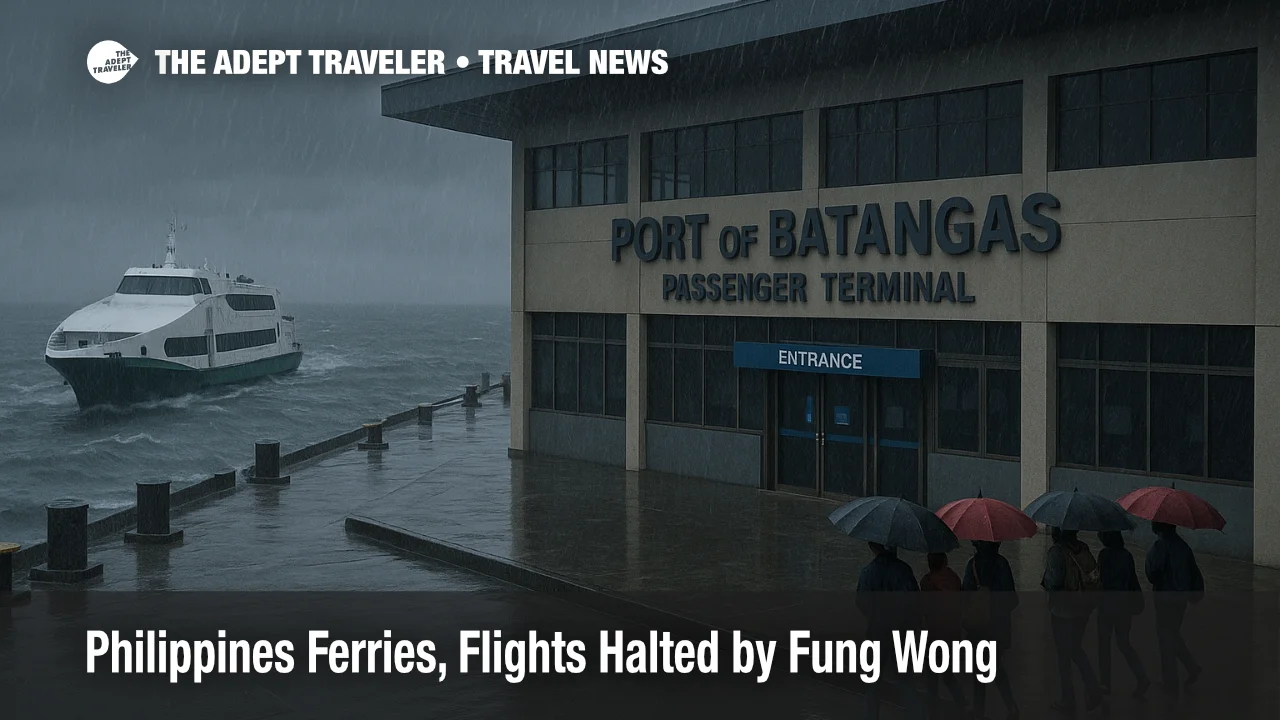Philippines Ferries, Flights Halted by Fung Wong

Key points
- Thousands stranded after Philippine Ports Authority and Coast Guard noted widespread sea travel suspensions tied to Fung Wong
- Civil Aviation Authority of the Philippines and airlines announced rolling domestic and select international flight cancellations and waivers
- Conditions and advisories vary by region and hour, travelers should verify port and flight status before heading to terminals
Impact
- Check Status Before Travel
- Confirm voyage with the Philippine Ports Authority or relevant Port Management Offices, then recheck before departure
- Use Airline Waivers Early
- Rebook within published waiver windows from Philippine Airlines, Cebu Pacific, and other carriers to avoid airport lines
- Plan Alternate Routings
- Where ferries are suspended, consider flights via unaffected airports, or overland options when roads are open and safe
- Expect Rolling Changes
- Advisories update through the day, build buffers for transfers and anticipate retimes as weather bands move
- Track Local Restrictions
- Local coast guard districts and airport notices determine when sailings and flights resume or extend suspensions
Philippine ports and airlines imposed broad suspensions from November 9 through November 12 as Super Typhoon Fung Wong, locally Uwan, disrupted sea and air travel across Luzon and the Visayas. The Philippine Ports Authority and Coast Guard published multiple no sail notices and canceled trip lists that left thousands stranded, while the Civil Aviation Authority of the Philippines reported hundreds of flight cancellations and diversions. Travelers should verify a vessel or flight's live status before leaving for any terminal, then recheck again en route as weather bands shift. Relief, resumption, and extended holds are being posted throughout the day.
Philippine Ports, Coast Guard, and local holds
Trip cancellations were posted by Port Management Offices and Coast Guard districts covering Central Visayas, Western Visayas, Bicol, and other corridors. Central Visayas authorities, for example, temporarily suspended all voyages in several zones under District Central Visayas, with additional localized stoppages around Iloilo, Guimaras, and Panay straits as conditions deteriorated. PPA summaries and district pages reiterated that PPA does not cancel sailings itself, rather voyages halt when the Coast Guard enforces a no sail policy under storm signals. Expect staggered resumptions as seas subside and inspections clear berths and vessels.
Latest developments
By November 10 to 11, national tallies and outlet summaries indicated several thousand stranded at ports and hundreds of flights canceled over a multi day window, with some routes resuming as local conditions improved and inspections concluded. District pages began noting partial resumptions where practicable, while other areas extended suspensions through successive bulletins. The pattern is rolling and highly local, which is why travelers should treat each crossing or flight as tentative until confirmed within a few hours of departure.
Airlines, airports, and waivers
Airlines issued cascading advisories and no fee change windows. Cebu Pacific published Fung Wong cancellation lists and advisories beginning November 7 and updated them as PAGASA raised signals across Bicol, Southern Luzon, and Eastern Visayas. Philippine Airlines posted cancellation notices and guidance on its news and events page and social channels, with additional updates as airport conditions changed. CAAP, the aviation regulator, warned of delays, cancellations, and diversions during the event, then reported staged resumptions at several regional airports once storm impacts eased and NOTAMs were lifted. If you have a booking in the next 72 hours, use carrier waivers now rather than waiting at the airport.
Background
How suspensions work in practice, the Coast Guard halts voyages when PAGASA storm signals and observed sea states meet thresholds that make small and medium craft operations unsafe, then local Port Management Offices reflect those holds in public lists. On the aviation side, airlines decide cancellations and retimes based on airport conditions, crew and aircraft positioning, and air traffic control constraints, while CAAP and airport authorities issue NOTAMs and advisories. Because typhoon bands move unevenly, a port or airport can go from operating to suspended, or vice versa, within a few hours. This is why rechecking status close to go time matters.
Analysis
For sea travel, the chokepoints are the country's busiest short sea corridors, for example Batangas to Mindoro and Luzon to island provinces, where closures strand travelers quickly. When Batangas sailings are off, look at overland options to alternate piers only if the Coast Guard for that district has cleared operations and roads are open. For flights, the most reliable fallback is to reroute via airports outside active storm bands, then connect by land or a shorter sea leg after conditions normalize, for example using flights into Cebu, Iloilo, or Davao when Manila and Bicol face repeated holds. If your itinerary includes tight ferry to flight links, split the trip or add an overnight. Use airline chat or app channels to action waivers and avoid airport counters. As the core of Fung Wong shifts north toward Taiwan, renewed on again, off again holds are likely in exposed coastal districts, even as interior routes reopen.
Final thoughts
Philippines ferries and flights disrupted by Fung Wong remains the operative headline through midweek. Treat every segment as provisional, use published waivers early, and keep checking PPA, Coast Guard, CAAP, and airline updates before you move.
Sources
- Philippine Ports Authority, traveler update post
- Coast Guard District Central Visayas, suspension notice
- Civil Aviation Authority of the Philippines, Typhoon Uwan advisory
- Cebu Pacific, Cancelled Flights Due to Severe Tropical Storm Fung-Wong
- Philippine Airlines, News and Events cancellations
- Philstar, LIST, Flights canceled due to Uwan
- Reuters, Super Typhoon Fung-wong slams into Philippines
